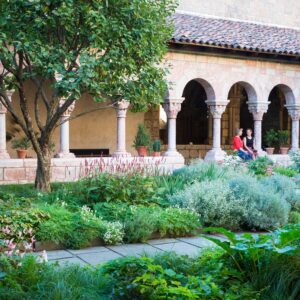 The Metropolitan Museum of Art possesses the finest, most comprehensive collection of Medieval and Byzantine art in the western hemisphere. It is held in two locations: the galleries of the Met’s main building on 5th Avenue and The Met Cloisters in Fort Tryon Park. This talk will explore the history of these two collections, and consider a selection of outstanding works of art that bring the medieval period compellingly to life. Dr. Mann will focus on works of art in the collection with a connection to plague, and look at some objects before and after the Black Death.
The Metropolitan Museum of Art possesses the finest, most comprehensive collection of Medieval and Byzantine art in the western hemisphere. It is held in two locations: the galleries of the Met’s main building on 5th Avenue and The Met Cloisters in Fort Tryon Park. This talk will explore the history of these two collections, and consider a selection of outstanding works of art that bring the medieval period compellingly to life. Dr. Mann will focus on works of art in the collection with a connection to plague, and look at some objects before and after the Black Death.
Dr. C. Griffith Mann was appointed The Metropolitan Museum of Art’s Michel David-Weill Curator in Charge of the Department of Medieval Art and the Met Cloisters in September, 2103. In this role, he is responsible for the medieval collections and curatorial staff in the Met’s main building, and for directing the staff and operations of the Met Cloisters, the branch of the Metropolitan Museum dedicated to the art and architecture of medieval Europe. Dr. Mann received his B.A. in art history and history from Williams College, and his Ph.D. in medieval art from The Johns Hopkins University. A specialist in the arts of late medieval Italy, he has published on civic patronage, painting, and devotion in Tuscany. As a curator, Dr. Mann has worked on exhibitions on the medieval cult of relics, the art and archaeology of medieval Novgorod, and French manuscript illumination of the 13th century. Dr. Mann formerly served as the Chief Curator and Deputy Director at The Cleveland Museum of Art, where he helped to lead the museum’s reinstallation, acquisition, and exhibition programs, and as medieval curator and Director of the Curatorial Division at The Walters Art Museum, where he worked on exhibitions and the permanent collection.
Arranged by Gary Banks
Bryan Hooper’s notes from the talk:
Dr. Griffith Mann, the Curator in Charge of the Department of Medieval Art and the Met Cloisters, last week described the origins of the medieval art and architecture collection at the Metropolitan Museum of Art, and took us to Tuscany to highlight the development of art in the time of the Black Death in the 14th century. The medieval art at the Met was initially gifted mainly by J.P. Morgan, and The Cloister’s collection was established by sculptor George Grey Barnard, a friend of Rodin, on a property overlooking the Hudson. This was acquired by John D. Rockefeller, Jr., who donated it to the Met in 1925, and built a new museum set up as a monastic cloister containing gardens designed by Frederick Law Olmsted, Jr. Dr. Mann concentrated his review of art during the plague years on the cities of Massa, Siena and San Gimignano, which were on the pilgrim trail from Pisa south to the Holy Land. The Black Death struck all sectors of society (sounds familiar) from nobles to peasants. The art of the time, particularly in frescoes in the duomos, the Italian cathedrals, addressed the subject in detail: the mainly illiterate population found stories in art that they could not access easily in any other way. Dr. Mann has more to tell on the Met and the medieval collection, and mentioned J.P. Morgan as a potential subject for a future talk to the DMA.
